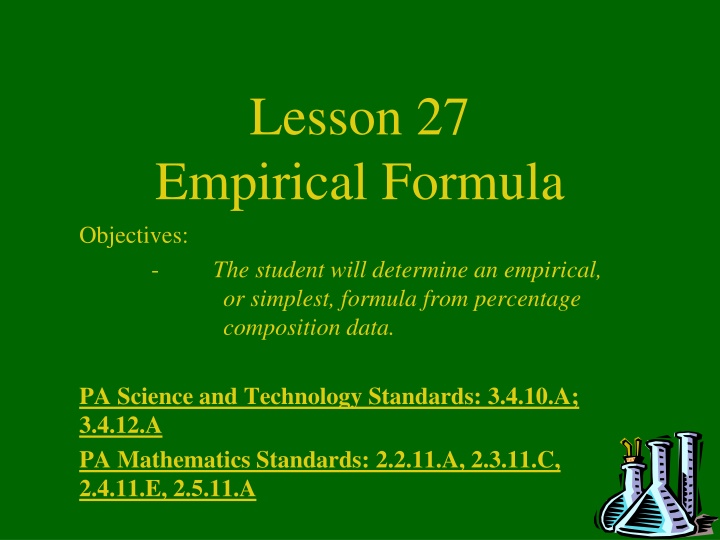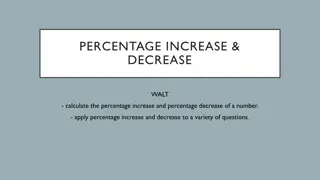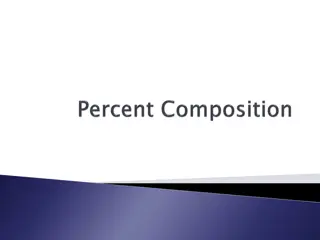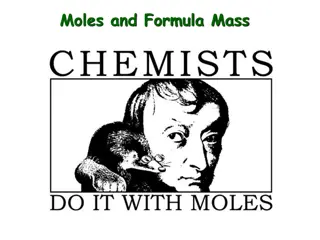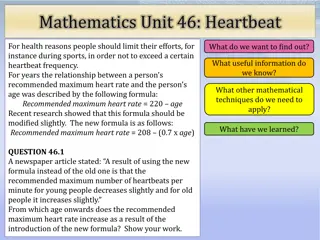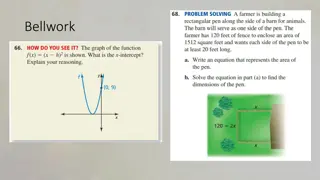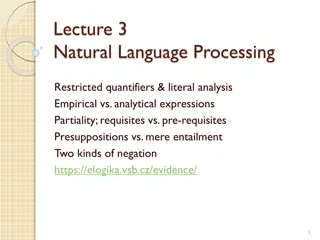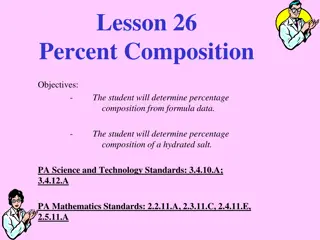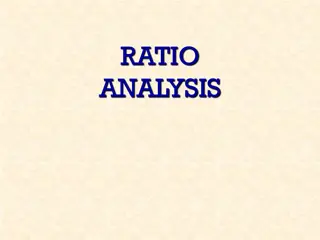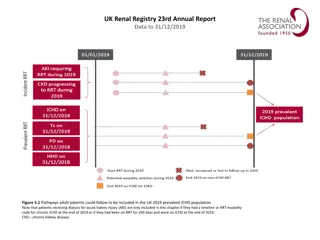Determining Empirical Formula from Percentage Data
In Lesson 27, students will learn to derive the empirical formula from percentage composition data. This practical skill is vital in science and technology fields. By analyzing the composition of a substance, learners will uncover its simplest formula. This lesson aligns with PA Science and Technology Standards, focusing on data interpretation and formula determination. Through hands-on exercises, students will enhance their understanding of chemical formulas and their applications in real-world scenarios.
Download Presentation

Please find below an Image/Link to download the presentation.
The content on the website is provided AS IS for your information and personal use only. It may not be sold, licensed, or shared on other websites without obtaining consent from the author.If you encounter any issues during the download, it is possible that the publisher has removed the file from their server.
You are allowed to download the files provided on this website for personal or commercial use, subject to the condition that they are used lawfully. All files are the property of their respective owners.
The content on the website is provided AS IS for your information and personal use only. It may not be sold, licensed, or shared on other websites without obtaining consent from the author.
E N D
Presentation Transcript
Lesson 27 Empirical Formula Objectives: - The student will determine an empirical, or simplest, formula from percentage composition data. PA Science and Technology Standards: 3.4.10.A; 3.4.12.A PA Mathematics Standards: 2.2.11.A, 2.3.11.C, 2.4.11.E, 2.5.11.A
I. Formulas can be determined from composition data A. When a new substance is discovered, the discoverers don t usually know the formula B. They do know the percentage composition C. This can be used to determine the formula, by converting everything from percentages to moles. D. These moles can then be divided by the smallest number that is determined, and this will give small, whole numbers which can be used to determine ratios.
E. Example As part of a science fair project, Antonio is analyzing the contents of fresh alkaline batteries. He has determined that one ingredient is a black powdery compound of 63% manganese and 37% oxygen. What is the compound s formula? 1. List the percentages Mn = 63% O = 37%
2. Determine the number of moles of each element present do this by assuming you have 100 g of the compound in question. 1 mol Mn 63 g Mn X -------------- = 1.1467 = 1.1 mol Mn 54.94 g Mn 1 mol O 37 g O X ------------ = 2.3125 = 2.3 mol O 16.00 g O
3. Select the smallest number of moles, and divide all your number of moles by that one: 1.1 mol Mn --- 1.1 = 1 mol Mn 2.3 mol O --- 1.1 = 2.1 mol O 1.0 mol Mn and 2.1 (which is close to 2) mol O translates into: MnO2 the formula written in smallest whole numbers.
II. Recap: 1. % to grams (assume 100g) 2. grams to moles 3. divide by the smallest
III. Special cases A. Sometimes when you get to the last step, you don t get numbers close to whole numbers. The following chart should help you with this: Range 0.1-0.2 0.3 0.4-0.6 0.7 0.8-0.9 Action Round down Multiply everything by 3 Multiply everything by 2 Multiply everything by 3 Round up B. When completed, you should have moles close enough to whole numbers to make an empirical formula.
IV. Examples: 1. You have a 23.6 g pile of a substance that is 75.0% Ti and 25% H. What is its empirical formula? TiH16 2. The percent composition of a substance is 48% Nickel, 17% Phosphorus, and 35% Oxygen. What is its empirical formula? Ni3P2O8
Empirical Formula Calculation The empirical formula is the formula with the lowest whole number ration between the elements. Example: the empirical formula of glucose which is C6H12O6 would be CH2O. 1. To calculate the empirical formula from the percent composition: 1. Change the % signs to grams. 2. Convert grams to moles 3. Divide all the numbers of moles by the lowest number of moles. 4. This gives you the ratio of the number of elements in the empirical formula. Example: 11% Hydrogen and 89% Oxygen 11g H and 89 g O 11g H ( 1 mole/ 1.0079g) = 10.91378 moles 89 g O( 1 mole/ 15.999g) = 5.562848 moles Oxygen has the smaller number of moles H 10.91378/ 5.562848 = 1. 96 = about 2 O 5.562848/5.562848 = 1 Ratio is 2 H s for every 1 O so the empirical formula is H2O
a. To calculate the empirical formula from experimental data: a. convert the grams given into moles for each element and follow same procedure as above.
Level 1 Determine the simplest formula for each compound listed below. In the first eight problems, the percentage composition of the compound is given. In the last two, laboratory data for the compound are presented. 1. 2. 3. 4. 5. 6. 7. 8. 9. 80.0% carbon, 20.0 % hydrogen 71.5% calcium, 28.5% oxygen 82.2% nitrogen, 17.8% hydrogen 85.7% carbon, 14.3% hydrogen 6.6% aluminum, 93.4% iodine 92.2% carbon, 7.8% hydrogen 23.5% potassium, 76.5% iodine 50.0 % sulfur, 50.0% oxygen An oxide of arsenic contains 3.26 g of arsenic and 1.04 g of oxygen. What is the empirical formula for this oxide? A sample of sodium oxide weighing 12.57 g contains 9.34 g of sodium. What is the empirical formula for this compound? 10.
Level 2 Determine the simplest formula for each compound listed below. In the first six problems, the percentage composition of the compound is shown. In the last four, laboratory data for the compound are given. 1. 2. 3. 4. 5. 6. 7. 8. 9. 63.5% silver, 8.2% nitrogen, 28.2% oxygen 14.3% nitrogen, 4.1% hydrogen, 81.6% bromine 24.7% potassium, 34.7% manganese, 40.5% oxygen 56.6% potassium, 8.68% carbon, 34.7% oxygen 9.92% carbon, 58.7% chlorine, 31.4% fluorine 37.8% carbon, 6.4% hydrogen, 55.8% chlorine 35.0% nitrogen, 5.0% hydrogen, 60.0% oxygen 27.4% sodium, 1.2% hydrogen, 14.3% carbon, 57.1% oxygen Analysis of a sample of a sulfur acid shows it to contain 0.17 g of hydrogen, 2.82 g of sulfur, and 5.67 g of oxygen. What is the simplest formula for this compound?
10. Analysis of a salt results in the following composition: 3.47 g of sodium, 2.12 g of nitrogen, and 7.27 g of oxygen. What is the empirical formula for this salt? 11. A barium salt is found to contain 21.93 g of barium, 5.12 g of sulfur, and 10.24 g of oxygen. What is the simplest formula of this compound? 12. An ore containing zinc, carbon, and oxygen, and weighing 485.35 g is analyzed and found to contain 46.59 g of carbon and 186.37 g of oxygen. What is the simplest formula for this compound?
Level 3 Determine the simplest formula for each compound listed below. In the first six problems, the percentage composition of the compound is given. In the last four, laboratory data for the compound are given. 1. 2. 3. 4. 5. 6. 7. 26.6% potassium, 35.4% chromium, 38.0% oxygen 74.0% carbon, 8.7% hydrogen, 17.3% nitrogen 69.8% iron, 30.2% oxygen 83.7% carbon, 16.3% hydrogen 50.8% zinc, 16.0% phosphorus, 33.2% oxygen 21.2% nitrogen, 6.1% hydrogen, 24.3% sulfur, 48.4% oxygen Chemical analysis of a 10.000 g sample of oil of wintergreen shows that it consists of 6.32 g of carbon, 0.53 g of hydrogen, and 3.16 g of oxygen. What is the simplest formula for oil of wintergreen? An acid is analyzed in the laboratory and the following results are obtained: 3.1% hydrogen, 31.6% phosphorus, 65.3% oxygen. What is the simplest formula for this acid? 8.
9. Examination of 3.2 x 10-2 g of an unknown white powder shows that the powder consists of an unknown amount of nitrogen, 2.6 x 10-3 g of hydrogen, 6.7 x 10-3 of phosphorus, and 1.37 x 10-2 g of oxygen. What is the simplest formula for this compound? 10. A rock sample weighing 5.88 x 104 g is known to contain calcium, phosphorus, and oxygen. The amount of the first two elements in this rock is found to be 2.28 x 104 g and 1.18 x 104 g respectively. What is the formula for the compound in this rock sample?
